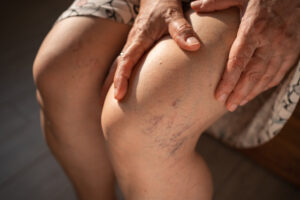Understanding Leg Vein Problems
You probably don’t think twice about your legs, but they carry you from place to place. All they ask for in return is a little TLC, especially for the veins that work tirelessly to pump blood back to your heart. But what happens if these veins start to falter? Explore how leg veins work and the various ways they can act up.
The Role of Leg Veins
Veins comprise one side of your circulatory system, transporting deoxygenated blood back to the heart. This task is especially tricky in the legs due to the distance from the heart and the constant fight against gravity. Thanks to one-way valves that prevent blood from flowing backward, leg veins carry out their duty commendably. That is until leg vein problems arise.
 What Happens if You Develop Vein Problems in the Legs
What Happens if You Develop Vein Problems in the Legs
While anyone can develop vein problems, your risk increases if you regularly sit or stand for long periods, suffer a blood vessel injury, experience hormonal changes, or have a family history of venous diseases. When vein problems in the legs occur, it throws off your entire circulatory system. This can lead to numerous symptoms, such as leg pain, swelling, and skin conditions. Severe complications may even occur if the problem goes untreated.
Here are some common types of vein problems that can occur in the legs:
- Spider veins are tiny, dilated veins visible just below the surface. They don’t usually cause pain, but their web-like appearance can be a cosmetic concern.
- Varicose veins are enlarged, twisted, and overfilled with blood. They often appear swollen and raised above the skin’s surface with a bluish-purple color. Leg pain, heaviness, itching, and discomfort are common symptoms of varicose veins.
- Deep vein thrombosis (DVT) is a serious condition where a blood clot forms in a deep vein, usually in the leg. It can cause pain, swelling, and potentially life-threatening complications if the clot dislodges and travels to the lungs.
- Venous insufficiency occurs when the leg veins’ valves become weak or damaged, hindering blood flow to the heart. This can cause blood to pool in the legs, leading to swelling and pain. Venous insufficiency is closely related to DVT and varicose veins.
- Venous ulcers are open sores that can form when blood doesn’t flow back to the heart properly, causing blood to pool and pressure to build, damaging the skin. These ulcers typically occur in the lower legs and may be brought on by DVT, diabetes, injuries, and prior surgeries.
Treat Leg Vein Problems at Arizona Vein and Laser Institute
If you’re struggling with any of the issues highlighted here, don’t let your quality of life take a hit. Arizona Vein and Laser Institute deliver high-quality, compassionate care to patients dealing with leg vein problems. Our experienced surgeons offer the necessary treatments to support good vein health, from minimally invasive EVLT treatment to surgical phlebectomy for stubborn varicose veins. Ready to say goodbye to leg pain and hello to healthier, happier veins? Contact us today to schedule a consultation at one of our six Phoenix-area locations.
